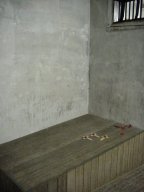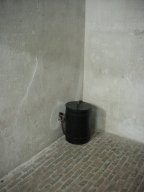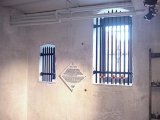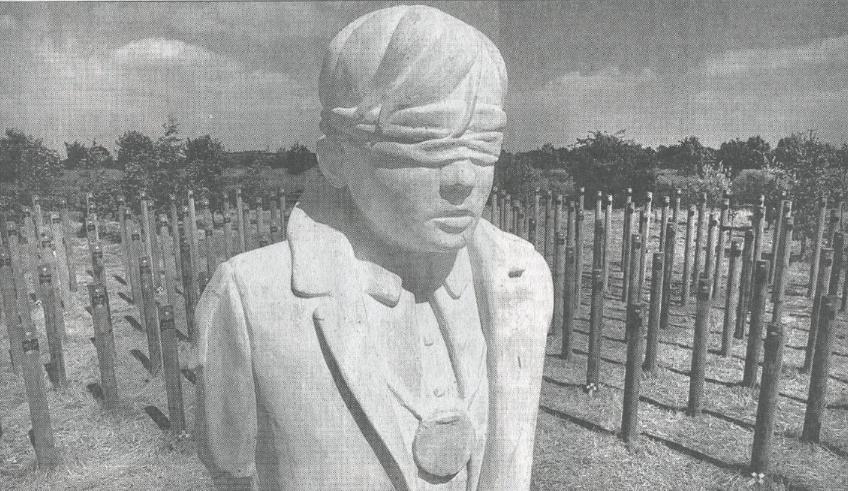



More than 300 British and Empire soldiers were court-martialled and executed during the First World War. Many of them received only summary trials and were shot the next morning.
HOW MANY OF THESE MEN WERE ACTUALLY GUILTY?
in any sense that we recognise today, is impossible to say. Some undoubtedly were, others were numbed by the stress, the squalor, the sight of so much death, or shell-shocked and driven to the edge of madness by being forced to endure the unendurable.
I believe these men were shot not because they were guilty, but AS AN EXAMPLE.
The
case of Sergeant W Stones - at 2.30am on Nov 26, 1916 (on the Somme), the
British came under heavy mortar fire in thick mist. Stones went out on patrol
with a lieutenant and came face to face with the enemy. The lieutenant was shot
dead and Stones ran back to raise the alarm. He jammed his rifle across the
trench to slow down the pursuing Germans - this cost his life. On return when it
was discovered he had no weapon he was arrested with "shamefully casting
away his arms". He was later tried and shot.
Many wish to see pardons for 307 soldiers who were executed by firing
squad after being found guilty of offences such as cowardice,
desertion, disobedience, quitting or sleeping at their post, throwing
away arms and striking a superior officer.
The men from Britain, New Zealand, Canada and other parts of the
Empire, were almost exclusively from the ranks, only two were
officers.
One such example of that of:-
PRIVATE HARRY FARR (25) no relation
Was shot by firing squad at dawn on October 1916. At the
court-martial two weeks earlier, Private Farr (8871 - 1st West Yorks)
was found guilty of "mis-behaving before the enemy in such a manner
as to show cowardice".
Private Farr simply refused to return to the trenches while suffering
from "shell shock". After two years on the Western Front he was so
badly affected that he spent five months in hospital. Despite this he
was found guilty at the court-martial and executed in Northern
France.
Private Farr's widow, Gertie Batstone was informed of his death but
learnt only later of the manner of it. Soon after, her war pension
was stopped.
In the Ypres salient there are 73 known graves of soldiers shot at dawn and a further 3 commemorated on the Menin Gate. Poperinge New Military cemetery holds an infamous record in that it contains the largest number of men to be executed by the British Army and buried in one place. The reason for this lies in the fact that such disciplinary matters were usually carried out when the battalions were in camp away from the front lines and Poperinge was one of the most important centres for military camps in the British sector.
In the courtyard between 1916 and 1919 a number of British Soldiers were executed. Records show at least 8 were definitely shoot here. The shooting post (1) preserved there was used only for the final execution on 19th May 1919.
After a defendant had been found guilty and sentenced to death and this had been confirmed by Field Marshall Sir Douglas Haig, the convicted soldier and his unit were informed. This was usually on the evening before the execution was scheduled to take place. A chaplain was assigned to remain in the man's cell for the night.
Next morning, at dawn, the execution took place. The man, sometimes drugged with morphia or alcohol was executed by a firing squad which was composed of at least six soldiers. One of their rifles was customarily loaded with a blank round.
The medical officer pinned a piece of white cloth over the man's heart, the priest pronounced benediction.
After both had withdrawn, the order was given to fire. Immediately the shots had been fired the MO would examine the man, if he was still alive, the officer in charge would deliver a coup de grace with a revolver.
In Poperinge, two of the cells in which the condemned men spent their final hours, were restored to the state they had been during the war. The cell adjacent to the street is furnished with a lavatory bucket (3) and a few planks (2) to sleep on. The cell with the two windows (4), gives views of the courtyard, were the executions took place.
Aeroplane
|
On the 26 July 1915 five men were executed on the ramparts of Ypres in what became the largest single execution by the British during the war. All the men were from the 3rd Worcesters, they were originally buried in the Ramparts Cemetery, three were later transfer here: |
|
|
Private J Robinson |
|
|
Private A D Thompson |
|
|
Private B Hartells |
Bleuet Farm
|
Private T Hawkins |
|
|
Private A Westwood |
|
|
Private F W Slade |
Dranoutre Military
|
Private F Broadrick |
Duhallow Advanced Dressing Station
|
Private J Seymour |
Ferme Oliver
|
Private G Watson |
|
|
Private R Hope |
Hagle Dump
|
Private W Dossett |
|
|
Private G Ainley |
La Clytte Military
|
Private L Mitchell |
Lijssenthoek Military
|
Private W Baker |
Locre Churchyard
|
Private A Evans |
|
|
Private J Byers (both aged 16 - 1st Royal Scots - tried 31/1/15 and executed together 6/2/15) |
|
|
Private G E Collins |
Locre Hospice
|
Private D Jetson |
|
|
Private W Jones |
Maple Leaf
|
Private A Parry |
Mendinghem
|
Private J J Hyde |
|
|
Private C Britton |
|
|
Private D Gibson |
Menin Gate Memorial
|
Private W Scotton |
|
|
Corp G H Povey |
|
|
Driver T Moore |
|
|
Private H Burden |
Nine Elms
|
Private J McFarlane |
|
|
Private J Nisbet |
Perth (China Wall)
|
Private G E Roe |
|
|
Private T Harris |
|
|
Private T Docherty |
|
|
Corp F Ives |
|
|
Private E Fellows (other two from the Ramparts - 3rd Worcesters) |
|
|
Private E Fraser |
|
|
Private L R Phillips |
Pont d'Achelles
|
Private E Worsley |
Poperinge New
|
Private J H Wilson |
|
|
Private J Bennett |
|
|
Private A Botfield |
|
|
Private R Stevenson |
|
|
Private B McGeehan |
|
|
Private R T Tite |
|
|
Private W H Simmonds |
|
|
2nd Lieut. E Sheffington Poole (one of three officers) |
|
|
Private J Crampton |
|
|
Private J W Fryer |
|
|
Private J S Michael |
|
|
Private J Stedman |
|
|
Serg. J T Wall (3rd Worc's) |
|
|
Private G Everill |
|
|
Private H Morris |
|
|
Private F C Gore |
Reningelst
|
Private R Loveless Barker |
|
|
Private F Loader |
|
|
Private W Smith |
Trois Arbres
|
Corp, G W Latham |
|
|
Private F Auger |
|
|
Private P Black |
|
|
Private J King (assumed name) |
Vlamertinge
|
Driver A Lamb |
|
|
Private A Richman |
Vlamertinge New
|
Private E Delargy |
White House
|
Private H H Chase |
|
|
Private W J Turpie |
|
|
Private A E Eveleigh |
|
|
Private R W Gawler |
Ypres Reservoir
|
Private T L Moles |
|
|
Private E Lawrence |
|
|
Private C F McColl |
Shot At Dawn ( Dedicated to Peter Goggins) by Katie Hopley (16)
How
can you kill someone
For
being afraid?
That
is disgusting!
You
should be ashamed
As
members are shot
Families
back home are torn apart
They’re
all branded
Where’s
the heart?
Not
killed by the enemy
They
now lose their name
Branded
as cowards
Their
families the same!
Over
300 men
They
all need to die?
A
thirst for blood
That’s
why!
So
end this injustice!
Give
them all back their name
Only
then will you end
Our countries 84 year shame!


The Unquiet Graves (by Piet Chielens and Julian Putkowski) guide takes you through the countryside around Ypres and Poperinge to visit the places of execution and graves of men 'shot at dawn' by the British Army in the Great War.
An excellent guide, available from the Flanders Field shop in the tourist centre.
The following article appeared in the Daily Telegraph (22nd June 2001), following the unveiling of a new memorial to those Shot at Dawn during the First World War.
RELATIVES of soldiers executed for desertion during the First World War renewed calls for the Government to pardon the men yesterday as they gathered for the unveiling of the Shot at Dawn memorial.
During the 1914-18 war, 346 British and Commonwealth soldiers were
executed, a figure higher than those recorded by both the French and Germans.
At the National Memorial Arboretum in Alrewas, Staffs, 306 stakes,
resembling the posts to which men were tied before being shot, have been driven
into the ground in memory of those executed. Each stake bears a metal plaque
bearing the deserter's name, age, rank and date of death.
In front of the semi-circle of stakes is a statue modelled on Private Herbert
Burden, of the Northumberland Fusiliers, who had lied about his age to join up
but was shot at 17 for desertion.
The Shot at Dawn campaign has been seeking a pardon for the 306 since
Public Record Office files released in 1990 outlined the prosecution cases
against the men.
Many had not been legally represented and most were suffering from shell
shock or post traumatic stress disorder.
No pardon is being sought for the other 40 men executed for either
murder, treason or mutiny.
Yesterday, Gracie Harris, who was three years old when her father, Harry
Farr, 25, was shot, was given the honour of unveiling the 10ft statue sculptured
by Andy De Comyn. Mrs Harris, an 87-year-old widow from Harrow, north London,
said: "1 am very proud and very grateful that now we have somewhere we can
come and pay honour to those soldiers who I consider were wrongly executed.
"Most were suffering from post traumatic stress, which today is
recognised as an illness."
Mrs Harris's father, a regular in the 1st Battalion West Yorkshire
Regiment, was sent to France as part of the British Expeditionary Force in
November 1914.
By May 1915 he had been admitted to hospital suffering from shell shock
and was treated for the next five months.
However, during the Somme offensive of 1916 he was ordered to take
rations to the front line.
As he approached amid the exploding shells that were falling on the
trenches he refused to go forward.
He was tried and found guilty of desertion at a court martial and
sentenced to death.
Mrs Harris did not find out until she was 40. "My mother was too
ashamed to tell me but it explains a lot of things that made my mother very sad
over the years."
Doris Sloan, 72, and her brother, John Campbell, 74, were at the
commemoration to remember their uncle, Bert McCubbin. He was a 22- year-old
private in the Sherwood Foresters when he was shot on July 30, 1916.
His mother later received a telegram saying her son had been killed by
"gunshot" and discovered the truth only after a friend of his returned
from the front line. Mrs Sloan said: "She went insane with grief. She never
received his medals and never received a pension because he was shot as a
coward.
"I have been fighting for a pardon for my uncle for more than a
decade. The Government just cannot admit they made a mistake.
"But it is a wonderful feeling to have a memorial to him and all
these others who I believe were wrongly killed. It is an honour to think his
name is now on the memorial."
Alongside the 274 British deserters, 23 Canadians, five New Zealanders,
four Africans and one Jamaican are remembered.
The New Zealand Government last year pardoned five deserters. John Hipkin,
chairman of the Shot at Dawn campaign, said: "In the vast majority of cases
these men had lost their minds.
" As Lord Moran, a medical officer during the war, said, 'a man's
courage wears out in battle as his uniform does.' I am still going to continue
to campaign especially as support is growing for our cause. This is a permanent
visible reminder of what the British Army did to their soldiers.
"But it is a great comfort to relatives of those executed soldiers.
They can see the courage of their loved Ones unveiled in a special way."
Andrew Mackinlay, Labour MP for Thurrock, who has campaigned in
parliament for a pardon, said: "I am deeply disappointed that the
Government still refuses to grant pardons but these people have already been
pardoned by the highest court in the land, British public opinion."
Out of 3,080 men sentenced to death during the war just 10 per cent were
executed and a number of these were under suspended sentences for a previous
offence.
